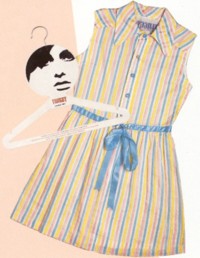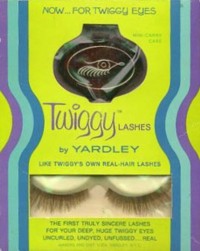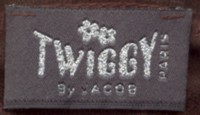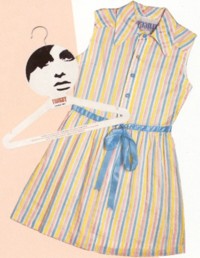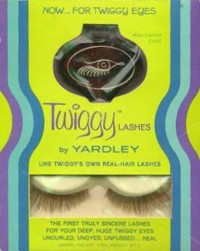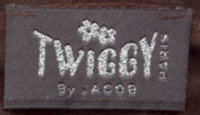The Twiggy clothing range came about when famous model Lesley Hornby – who became known to the world as Twiggy – was asked in September 1966 to launch her own label by a well-known dress manufacturer called Berkertex. They flew her out to Tunisia to sign a contract, but when she discovered that what they were really after was her famous name on a range of clothing they had already begun creating she decided to go ahead with her own range, but start it with a company that would allow her to have real input.
“Taramina Textiles made old-lady frocks and wedding dresses. The company was run by two brothers-in-law, Leonard Bloomburg and Sydney Hills… not surprisingly the range was called Twiggy Dresses. The teenage market was something quite new to them which was great for us, as it meant no pre-conceived ideas or old stock to get rid of. Right from the start it was agreed everything would be things that I would be happy to wear.”
Twiggy even had input into choosing the designers – Pamela Proctor and Paul Babb who weren’t much older than her and came straight from the Royal College of Art. She would meet up with them at Great Portland Street two or three times a week to discuss designs and ideas, and as someone who had always wanted to be a clothes designer and had made many of her own clothes, Twiggy truly envied the two designers she worked so closely with. Paul Babb provided Twiggy with a humorous friendly back-up during trips abroad to promote the range, while Pamela Proctor was described as “…marvelous. She’s really on the same wavelength as me and always knows what I like.”
The range was heavily influenced by Quant and Courreges, featured acid-drop colours and fabulous daisy prints, and had a distinct retro feel influenced by the styles of the Roaring Twenties that Twiggy had such a love of. “I dress very strangely some times and the things that suit me wouldn’t suit everyone else. So things have to be adapted and sometimes toned down to make them commercial.”
The range was launched to the Press in November 1966 via a range of photographs taken by Barry Lategan (whose photo had launched her career as “the face of ’66”), an advertising campaign using the slogan “it’s a twiggy world”, and amazingly Twiggy’s only catwalk modeling. “In those days you didn’t do both and the top girls were photographic models only. Given the fact that nothing ever fitted me (what you don’t see in the photographs is the bulldog clips and safety pins at the back) its a good thing. But the Twiggy Dresses were made with me in mind.”
The range was highly priced – ranging between 6 and 12 guineas at a time when a decent high street skirt would be 50 shillings and a Dollyrockers dress cost about £7. Apart from the famous celebrity behind the expensive label, an added sales technique was the unusual “portrait hanger” that came free with every piece of clothing.
At the start of 1967, 150 outlets in the USA had expressed an interest in the clothing range so long as Twiggy herself was part of the package, so she headed over to the US to launch the range over there and her visit was turned into a series of three documentaries for ABC Television. A million dollars of orders were placed in one afternoon before Twiggy had even left New York, but due to there being no American manufacturers backing the label, pirated copies flooded the market before the company could supply it’s huge US market.
In 1968 Twiggy visited Munich to launch the label in Germany.
In 1970 Twiggy visited the stockrooms to look for something and discovered that all of the dresses there had a new label – “Miss T”. It turned out that the manufacturers had been fulfilling the Twiggy dress orders with half “Twiggy” dresses and half “Miss T” dresses which Twiggy had no input or financial involvement with.
As well as the Twiggy Dresses range numerous other Twiggy items were launched, including Hampton Trimfit’s “Twiggy Hosiery” in 1967 and Yardley’s “Twiggy Lashes” and “Twiggy Eye Paint”.
Written by premierludwig



